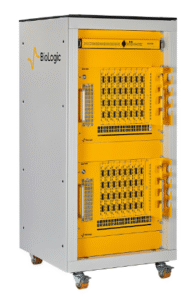How does a battery cycler work?
A battery cycler will analyse battery function through charge/discharge cycles, by measuring the cells response over time. During battery cycling, a number of parameters can be measured, including capacity, efficiency of the battery and self-discharge. The battery cycler is also suitable for use with capacitors and supercapacitors.
Each module of the BCS-9xx series is composed of 8 channels, and is equipped with five charge currents ranges. The BT-Lab software offers great usability for battery cycling. With the Modulobat technique it is possible to work with 11 different control modes, which allows for easy programming of unique sequences.
In battery cycling, the classic charge/discharge testing measures the net result of all the electrochemical processes taking place inside the cell. In addition to charge/discharge testing, the use of Electrochemical Impedance Spectroscopy (one of the control modes) has become more popular in recent years. EIS, especially in the low frequency range, can be used to monitor and control the degradation of the battery,
What processes are generally involved in battery cycling/testing?
- Initial Conditioning (optional): Some tests include a preliminary conditioning phase to stabilize the battery.
- Charging: The battery is charged at a specified current or voltage until it reaches the target state of charge.
- Rest Periods: The battery may be idle for a set time to allow temperature and voltage stabilization.
- Discharging: The battery is discharged at a controlled current or voltage to assess capacity and performance.
- Data Recording: Voltage, current, capacity, and other parameters are measured and logged during each cycle.
- Repeat Cycles: The charge-discharge cycle is repeated multiple times to evaluate cycling stability, capacity fade, and overall lifespan.
- Electrochemical Impedance Spectroscopy (EIS)(optional): By applying small alternating current signals and measuring the response across different frequencies, EIS helps to provide detailed information on internal battery processes, such as charge transfer resistance and diffusion.
- Final Analysis: After completing the desired number of cycles, data are analyzed to determine capacity degradation, efficiency, internal resistance, and other key metrics.
This process helps evaluate battery durability, efficiency, and suitability for specific applications.



